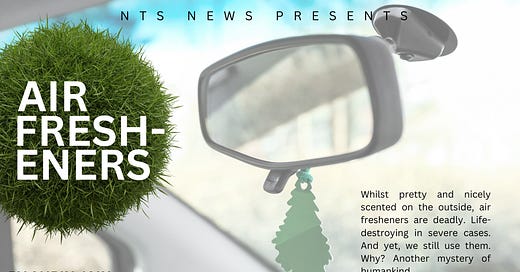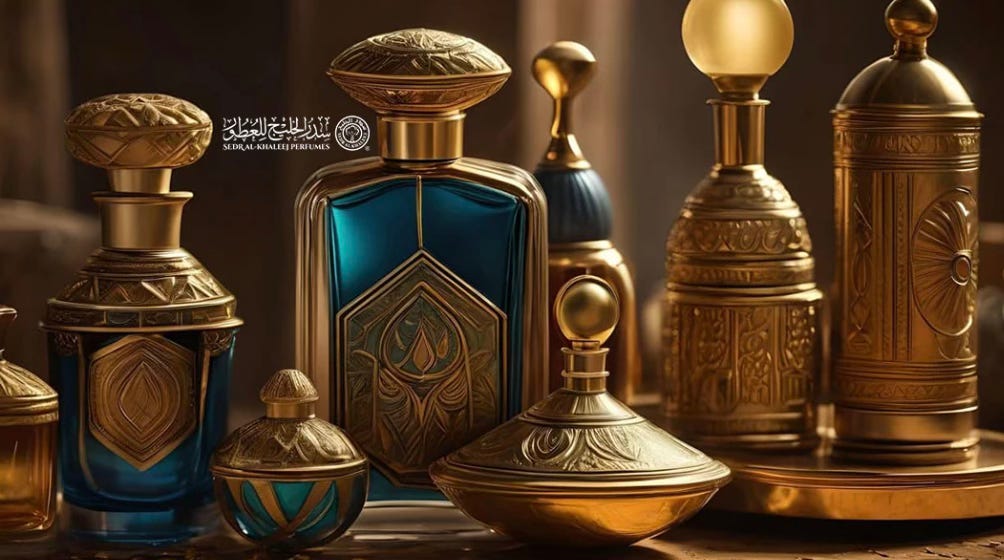Behind The Irresistibly Alluring Smell of Air Fresheners
Behind the succulent, decadent scents air fresheners have to offer, we explore the negative effects the artificial creations have.
Air fresheners, at first glance, are a compact item that offers any scent of your choosing - whether that’s a cherry-flavoured jelly bean or a soothing rose and chamomile blend. Coming in at just a few dollars, the idea that such a cheap product could sweeten up the air in minutes has made air fresheners irresistible to the public. However, some scientists have delved deeper into the product, and found unpromising, negative results…
In this article, we’ll cover the history, effects and many more subjects of the air freshener.
PART I: HISTORY
Like many other modern products that exist today, air fresheners evolved into this optimal form across hundreds of years, evolving from simple scents to everlasting, preserved smells that were sure to bring immense delight.
At first, just before the 18th century, citizens curated selections of smells through grinding herbs and spices, boiling flower petals and swirling organic matter.
Even without the advanced technology we see today, people in those times managed to discover that scent can play a role in mood and stress levels if utilised correctly. With this piece of information, scent slowly emerged into other fields of life (including medical treatment, ceremonies and festivals and even religious activity).
Fast-forward to the 1700s and 1800s, the Romans saw the vast potential that simple smell had, and started creating selections of strongly-scented herbs which they then sold at exorbitant prices. The Egyptians quickly caught on and started devising their own scent-trading regime, quickly overtaking the Romans as world leaders in scent production.
Experts now felt that the scent market couldn’t be managed with bundles of herbs or ground spice mixes, which is when Tapputi came into the scene. The lady, a now world-famous person who lived in Mesopotamia (present day Iraq, Iran, Turkey, Kuwait and Syria), is thought to be Earth’s first chemist, and through her extensive knowledge created the perfume invention.
Perfume captured the complexities, the intricacies and small details of almost any scent, so naturally the perfume market instantly exploded. Hundreds of companies were suddenly competing for a prime spot in the newly created market, and most of them were based in France (part of the reason we see France today as the world perfume capital).
The most entrepreneurial minds, however, were still not satisfied that the scent market was completely covered by perfume. In 1948, odour experts created the earliest version of the air freshener - but instead of aiming it towards consumers, they sold it to the English military as a method to efficiently deliver pesticides. Julius Sämann (somehow) commercialised the now ex-military product, but added his own adjustments.
When newspaper firms questioned him on his inspiration, Sämann shared enthusiastic stories about a Canadian journey. He was, according to the gathered information, studying the magic of local trees growing there, and particularly focused on their unusually succulent smell. When he returned to his native country, he “heard a milkman” complaining about the rotten, rancid smell of expired milk, which is where “the idea sparked.”
Little Trees was created by the inspired man, and is still running today (in 2022, they made just shy of $90 million in sales). They create small, tree-shaped air fresheners with a fresh pine smell that will last for months.
Whilst the Little Trees team are thrilled at skyrocketing sales, little do they know that, if every single person in the world read Part II of this article, their sales would plummet.
PART II: ALLURING SCENT DOESN’T MEAN THE RIGHT INTENT
At the beginning of the article, we described air fresheners as sweet and scented on the outside but purely malicious on the inside. Like many artificially-created products, the chemicals within them have baleful effects when inhaled or ingested.
Whilst studies have revealed this information, to be sure, we checked what manufacturers of this product had to say in response to this drawback. After meticulous research, we found that whilst they claim air fresheners make up for the artificial contents by removing otherwise hurtful impurities in the air, there’s no real data or evidence to back this up. In the few legally required documents these businesses must publicly disclose, certain chemicals were classified as “volatile” by national health agencies and deathly in regular intake. One of the highest-measuring compounds found in an air freshener is called formaldehyde, a highly toxic chemical acting as a preservative, and is recognised as a carcinogenic substance by the World Health Organisation.
Another element of the hazardous ingredient list is benzene, a sweet-smelling chemical that can trigger extreme drowsiness, headaches, mild dizziness when consumed or inhaled in low amounts, but can render a person unconscious if in larger quantities.
Furthermore, air fresheners aren’t just acute destroyers of human health - they’re mass pollutants. The 100+ chemicals inside each other form a chemical reaction, before reacting once again with existing particles currently in the air. This sudden merge triggers the birth of more pollutants, where the cycle repeats, eventually creeping into our atmosphere and wreaking havoc with pollution.
Should air fresheners be banned? Should these brands be more open with their products’ contents?
QUICK NOTICE
Wait! Don’t go yet! We have a few notices we’d like to quickly share before we conclude this article.
Chess Daily, Logic+, Magic Squares, Math-Bend, Jokes, Riddle Of The Week and Other Puzzles
Wondering where NTS NEWS has been? Whilst many of our readers feel that we’ve branched out and forgot about this platform for a while, we’ve actually been building on our content right here on the website! We’ve now introduced a Chess Daily feature, math challenges, jokes and riddles, summery recipes…the list goes on. We highly recommend you take a look at our updates - to go to our normal homepage, visit ntsnews.substack.com, and to view our puzzles, go to ntsnews.substack.com/s/puzzles.
The “Help” Section
For the past six months, NTS NEWS has lacked a clear, easy way to access a troubleshooting guide, Privacy Policy and Terms & Conditions. Instead of providing long lists of complicated documents, we fused all three together on one long “Help” page which you can find on our homepage, or by clicking this.
Thank you!
Image sources: For title image, text and sphere created by NTS studios; Air Freshener background by Little Tree, Incorporated. For other images: The European Union Science Hub, Out of Milk, Sedral Khakjeej (An Arabic Perfumery)
Research Sources: University of Massachusetts Amherst, MADE SAFE (The Toxin Program), The Washington Post, The Guardian, Poison Control, HowStuffWorks, Amazon UK, Fabulosa, Little Tree, Wikipedia, Direct365, Fresh Products, ELLE Decor, My Air Freshener, Arnold Clark, HYscent, Luxury Car Scents, AirWickArabia, Weekly, Retromotor, Bloomberg, The News Wheel, Ready Spaces & The New York Times.








Fantastic article Ahrin. I am also wary of the chemicals that are used in air fresheners, candles, etc. and prefer the natural aromas you mentioned such as spices and flowers.
This article was excellently written. I even learned a new word - "baleful".